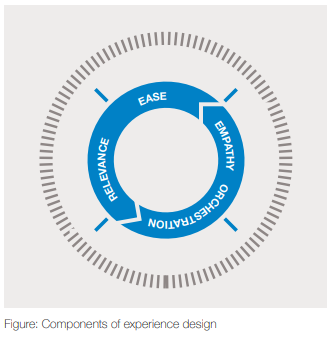The concept of ‘Experience Design’ may seem distant to companies interested in compiling and utilizing data on flow, pressure, temperature, and vibration to gain competitive advantage; however, correct application of the techniques of Experience Design can enable improvements in the outcomes of the emerging energy and chemicals digital landscape.
So, how do you build a good experience? It starts by understanding the journey that the engineer or operator will have in applying digital technology to fulfill his or her duties in a role. A journey is made up of:
- Interactions – a discrete point of engagement between the engineer or operator and the wider organization (e.g. a notification regarding the vibration pattern on a centrifugal pump)
- Touchpoints – the organizational people, process, technology, and data elements which collectively enabled the interaction (e.g. the review undertaken between an engineer, planner, and operator of the vibration and preventive maintenance history of the pump)
- Moments that Matter – the interactions that drive the most value for the engineer or operator and the organization (e.g. the work order that the engineer asks be written to inspect the pump)
- Channel – the medium in which the interaction took place (e.g. via a web browser, mobile device, or physically interacting with a control panel)
By reviewing the engineer or operator’s journey in the digital landscape, an organization can begin to identify those interactions that bring the most value. These “moments that matter” are crucial to understand as they represent how the experience will be remembered. An organization must focus on four areas to design a “moment that matters”:
- Ease – it is simple for the engineer or operator to derive value from experiences. Experiences are apparent, accessible, effortless, and uncomplicated. For example, a notification about a troubling vibration pattern on a centrifugal pump indicates the location, equipment tag, make, and model of the pump as part of the notification.
- Relevance – solutions and services add value through utility and by meeting the basic needs of the engineer or operator, all at the right time and right place. For example, engineers receive mobile notifications while operators receive notifications on their operations dashboard in the control room.
- Orchestration – specific interactions and touch points are designed and delivered as an end-to-end experience versus a discrete transaction. For example, a notification about troubling vibration patterns on a centrifugal pump provides direct links to vibration, temperature, and pressure readings as well as the work order history.
- Empathy – experiences are based on an in-depth understanding of the behaviors, feelings, and motivations of the engineer or operator.
Beyond these areas, consideration should be given to humanizing the experience as well. This can be achieved by ensuring that an experience is adaptive (evolves to changing needs) and cognitive (the needs of the engineer or operator are understood intuitively). This could mean taking an agile approach to deployment of the digital landscape to ensure that it continually aligns with the needs of the engineer or operator. By focusing on both the core areas of experience and the elements that humanize it, the journey for the engineer and operator will be positive.
Click here to read part two of our Designing with the operator and engineer in mind blog series.
